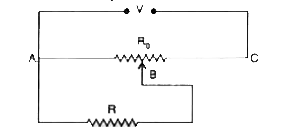Find the ratio of de-Broglie wavelengths associated with two electrons accelerated through 25 and 36 V.Solution in Kannada
V1=25V,V2=36V
De-Broglie wavelength of an electron:
λ=1.227√V
λ1=12.27√V1
and λ2=12.27√V2
∴λ1λ2=√V2V1=√3625
λ1λ2=65
Topper's Solved these Questions
- DUAL NATURE OF RADIATION AND MATTERBook:OSWAAL PUBLICATIONChapter:DUAL NATURE OF RADIATION AND MATTERExercise:TOPIC-2 DE-BROGLIE RELATION (SHORT ANSWER TYPE QUESTIONS-I)
Explore 9 Videos
- DUAL NATURE OF RADIATION AND MATTERBook:OSWAAL PUBLICATIONChapter:DUAL NATURE OF RADIATION AND MATTERExercise:TOPIC-2 DE-BROGLIE RELATION (SHORT ANSWER TYPE QUESTIONS-II)
Explore 2 Videos
- DUAL NATURE OF RADIATION AND MATTERBook:OSWAAL PUBLICATIONChapter:DUAL NATURE OF RADIATION AND MATTERExercise:TOPIC-1 PHOTOELECTRIC EFFECT (NUMERICAL PROBLEMS)
Explore 15 Videos
- CURRENT ELECTRICITY Book:OSWAAL PUBLICATIONChapter:CURRENT ELECTRICITY Exercise:TOPIC-3 (POTENTIOMETER & APPLICATIONS) (NUMERICAL PROBLEMS)
Explore 2 Videos
- ELECTRIC CHARGES & FIELDSBook:OSWAAL PUBLICATIONChapter:ELECTRIC CHARGES & FIELDSExercise:(TOPIC -2)Numerical Problems
Explore 5 Videos
Similar Questions
What are matter waves? Derive an expression for the de Broglie wave length.
View SolutionAn electron and a photon each have a wavelength of 1.00 nm. Find (i) their momentum (ii) the energy of the photon and (iii) K.E of electron
View SolutionThe threshold wavelength of a photosensitive metal is 662.5 nm. If this metal is irradiated with a radiation of wavelength 331.3 nm, find the maximum kinetic energy of the photoelectrons. If the wavelength of radiation is increased to 496.5 nm, calculate the change in maximum kinetic energy of the photoelectrons. (Planck's constant h=6.625×10−34 Js and speed of light in vacuum=3×108ms−1)
View SolutionA resistance of RΩ draws current from a potentiometer. The potentiometer has a total resistance R0Ω.A voltage V is supplied to the potentiometer. Derive an expression for the voltage across R when the sliding contact is in the middle of the potentiometer.

View SolutionAn atom was earlier assumed to be sphere of radius a having a positively charged point nucleus of charge +Ze at its centre . This nucleus was believed to be surrounded by a uniform desity of negative charge that made the atom neutral as a whole.
Use this theorem to find the electric field of this atom at a distance r(r>a) from the centre of the atom.
View SolutionAn electron is accelerated through a potential difference of V volit .Find th e de Broglie wavelength associated with electron.
View SolutionAn electron is accelerated by a potential difference of 25 V. Find the de Broglie wavelength associated with it.
View Solution104 वोल्ट से त्वरित इलेक्ट्रॉन से सम्बद्ध दे-ब्रोग्ली तरंग दैर्ध्य ज्ञात कीजिए।
View SolutionThe de Broglie wavelength associated with an electron accelerated through a potential differenece V is λ. What will be its wavelength when the accelerating potential is increased to 4V ?
View SolutionThe De broglie wavelength associated with protons accelerated through V volt will be :
View Solution400 V विभवान्तर से त्वरित इलेक्ट्रॉन से सम्बद्ध दे-ब्रॉग्ली तरंगदैर्ध्य की गणना कीजिए।
View SolutionFind the ratio of de-Broglie wavelengths associated with two electrons A and B which are accelerated 8V and 64 Volts respectively.
View SolutionWhat is the de-Broglie wavelength associated with an electron accelerated through a potential of 100V ?
View SolutionThe de Broglie wavelength associated with an electron accelerated by a potential of 64 V is
View SolutionFind the ratio of de-Broglie wavelengths associated with two electron beams accelerated through 25 V and 36 V respectively.
View Solution